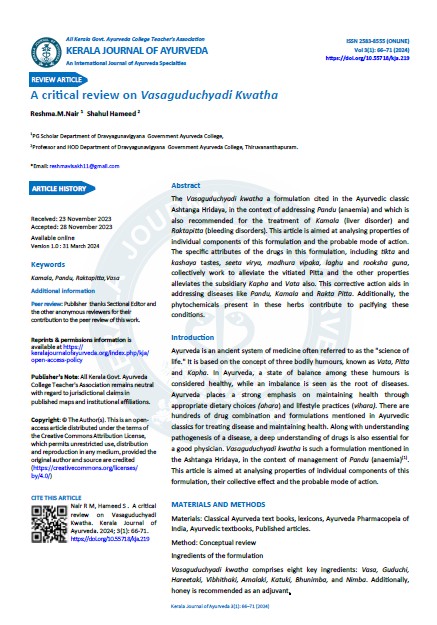A critical review on Vasaguduchyadi Kwatha
DOI:
https://doi.org/10.55718/kja.219Keywords:
Kamala, Pandu, Raktapitta, VasaAbstract
The Vasaguduchyadi kwatha a formulation cited in the Ayurvedic classic Ashtanga Hridaya, in the context of addressing Pandu (anaemia) and which is also recommended for the treatment of Kamala (liver disorder) and Raktapitta (bleeding disorders). This article is aimed at analysing properties of individual components of this formulation and the probable mode of action. The specific attributes of the drugs in this formulation, including tikta and kashaya tastes, seeta virya, madhura vipaka, laghu and rooksha guna, collectively work to alleviate the vitiated Pitta and the other properties alleviates the subsidiary Kapha and Vata also. This corrective action aids in addressing diseases like Pandu, Kamala and Rakta Pitta. Additionally, the phytochemicals present in these herbs contribute to pacifying these conditions.
References
Translator Prof Sreekanthamurthy K.R. Astanga Hridaya. Varanasi: Chaukamba Krishnadas Acadamey; 2014. 449 p. (Krishnadas Ayurveda Series; vol. 2).
The Ayurvedic Pharmacopoeia of India. New Delhi: Govt of India,Ministry of Health & Family Welfare,Department of AYUSH; 207–208 p. (PART 1; vol. 1).
The Ayurvedic Pharmacopoeia of India. New Delhi: Govt of India,Ministry of Health &Family Welfare,Department of AYUSH; 70–72 p. (Part 1; vol. 1).
The Ayurvedic Pharmacopoeia of India. New Delhi: Govt of India,Ministry of Heath & Family Welfare,Department of AYUSH; 80–82 p. (Part 1; vol. 1).
The Ayurvedic Pharmacopoeia of India. New Delhi: Govt of India,Ministry of Heath & Family Welfare,Department of AYUSH; 44–45 p. (part 1; vol. 1).
The Ayurvedic Pharmacopoeia of India. New Delhi: Govt of India,Ministry of Health & Family Welfare,Department of AYUSH; 6–8 p. (Part-1; vol. 1).
The Ayurvedic Pharmacopoeia of India. New Delhi: Govt of India,Ministry ofHealth & Family Welfare,Department of AYUSH; 91–93 p. (Part 1; vol. 2).
The Ayurvedic Pharmacopoeia of India. New Delhi: Govt of India,Ministry of Health & Family Welfare,Department of AYUSH; 124–127 p. (part 1; vol. 1).
The Ayurvedic Pharmacopoeia of India. New Delhi: Govt of India,Ministry ofHeath & Family Welfare,Department of AYUSH; 133–135 p. (part 1; vol. 2).
Chunekar K.C. Commentator, Pandey.G.S Editor. Bhavaprakasa Nighantu. Varanasi: Chaukambha Bharathi Acadamey; 306–307 p. (Ayurveda series).
Chunekar K.C. Commentator, Pandey.G.S Editor. Bhavaprakasa Nighantu. Varanasi: Chaukambha Bharathi Acadamey; 258–259 p. (Ayurveda series).
Chunekar K.C. Commentator, Pandey.G.S Editor. Bhavaprakasa Nighantu. Varanasi: Chaukambha Bharathi Acadamey; 5–7 p. (Ayurveda series).
Chunekar K.C. Commentator, Pandey.G.S Editor. Bhavaprakasa Nighantu. Varanasi: Chaukambha Bharathi Acadamey; 8–9 p. (Ayurveda series).
Chunekar K.C. Commentator, Pandey.G.S Editor. Bhavaprakasa Nighantu. Varanasi: Chaukambha Bharathi Acadamey; 10–12 p. (Ayurveda series).
Chunekar K.C. Commentator, Pandey.G.S Editor. Bhavaprakasa Nighantu. Varanasi: Chaukambha Bharathi Acadamey; 67–68 p. (Ayurveda series).
Chunekar K.C. Commentator, Pandey.G.S Editor. Bhavaprakasa Nighantu. Varanasi: Chaukambha Bharathi Acadamey; 70–72 p. (Ayurveda series).
Chunekar K.C. Commentator, Pandey.G.S Editor. Bhavaprakasa Nighantu. Varanasi: Chaukambha Bharathi Acadamey; 314–315 p. (Ayurveda series).
Translator Prof Sreekanthamurthy K.R. Astanga Hridaya. Varanasi: Chaukamba Krishnadas Acadamey; 2014. 65 p. (Krishnadas Ayurveda Series; vol. 1).
Shoaib A. A systematic ethnobotanical review of Adhatoda vasica (L.), Nees. Cell Mol Biol Noisy--Gd Fr. 2022 Jan 2;67(4):248–63.
Antul K, Amandeep P, Gurwinder S, Anuj C. Review on Pharmacological Profile of Medicinal Vine: Tinospora cordifolia. Curr J Appl Sci Technol. 2019 Jun 3;1–11.
Hassan Bulbul MdR, Uddin Chowdhury MN, Naima TA, Sami SA, Imtiaj MdS, Huda N, et al. A comprehensive review on the diverse pharmacological perspectives of Terminalia chebula Retz. Heliyon. 2022 Aug 14;8(8):e10220.
Kumari S, MythiliKrishna J, Joshi A, Gurav S, Bhandarkar A, Agarwal A, et al. A pharmacognostic, phytochemical and pharmacological review of Terminalia bellerica. J Pharmacogn Phytochem [Internet]. 2017 Oct 1 [cited 2023 Nov 23]; Available from: https://www.semanticscholar.org/paper/A-pharmacognostic%2C-phytochemical-and-review-of-Kumari-MythiliKrishna/9069b762adbb2df7c7375a240217c2a562fbb644
Hasan M, Islam M, Islam R. Phytochemistry, pharmacological activities and traditional uses of Emblica officinalis: A review. Int Curr Pharm J. 2016 Jan 18;5:14.
Almeleebia TM, Alsayari A, Wahab S. Pharmacological and Clinical Efficacy of Picrorhiza kurroa and Its Secondary Metabolites: A Comprehensive Review. Molecules. 2022 Nov 29;27(23):8316.
Patil K, Dhande S, Kadam V. Therapeutic Swertia chirata - An Overview. Res J Pharmacogn Phytochem. 2013 Aug 29;5(4):199–207.
Gupta A, Ansari S, Gupta S, Narwani M, Gupta M, Singh M, et al. Therapeutics role of neem and its bioactive constituents in disease prevention and treatment. 2019 Jan 1;680–91.
Translator Prof Sreekanthamurthy K.R. Astanga Hridaya. Varanasi: Chaukamba Krishnadas Acadamey; 2014. 122 p. (Krishnadas Ayurveda Series; vol. 2).
Translator Prof Sreekanthamurthy K.R. Astanga Hridaya. Varanasi: Chaukamba Krishnadas Acadamey; 2014. 29 p. (Krishnadas Ayurveda Series; vol. 2).
Patil VS, Harish DR, Vetrivel U, Roy S, Deshpande SH, Hegde HV. Hepatitis C Virus NS3/4A Inhibition and Host Immunomodulation by Tannins from Terminalia chebula: A Structural Perspective. Mol Basel Switz. 2022 Feb 5;27(3):1076.
Zhou NJ, Geng CA, Huang XY, Ma YB, Zhang XM, Wang JL, et al. Anti-hepatitis B virus active constituents from Swertia chirayita. Fitoterapia. 2015 Jan;100:27–34.





